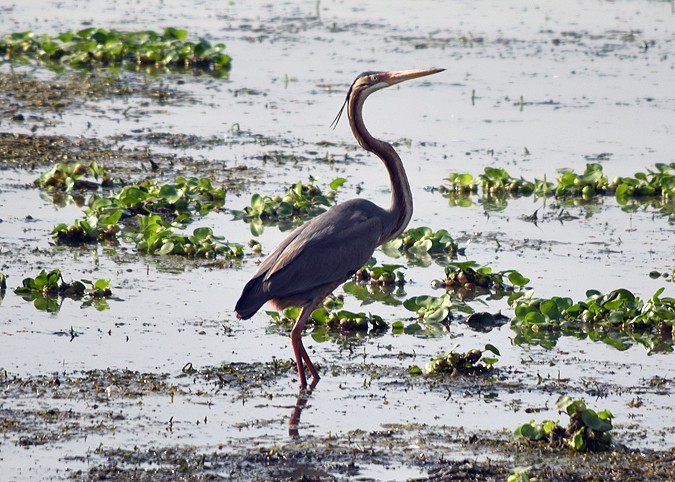Purple Heron
A species of Great herons Scientific name : Ardea purpurea Genus : Great herons
Purple Heron, A species of Great herons
Botanical name: Ardea purpurea
Genus: Great herons
Content
Description People often ask General Info
 Photo By Sudipta Nandy , used under CC-BY-SA-4.0 /Cropped and compressed from original
Photo By Sudipta Nandy , used under CC-BY-SA-4.0 /Cropped and compressed from original Description
The purple Heron is a beautiful bird that is highly adapted to its wetland habitat, where it primarily feeds on fish and other prey. Its long neck and sharp beak make it a skilled hunter of fish and small prey in shallow waters. It is easily recognizable. 
Size
76 - 89 cm
Colors
Brown
Gray
Life Expectancy
25 years
Nest Placement
Tree
Feeding Habits
Purple Heron mainly prey on fish, amphibians, and insects but also consume mammals, reptiles, and various aquatic creatures. Purple Heron show distinct foraging behaviors, stealthily stalking or standing motionless in water before swiftly striking. Adapted to diverse habitats, purple Heron's versatile feeding allows exploitation of local food resources.
Habitat
Purple Heron thrives in wetland regions with dense aquatic plants like reed beds, as well as brackish lagoons and mangroves. These adaptable birds also inhabit freshwater environments, including lakes and rivers, and can extend to man-made areas like rice fields. Generally residing at low altitudes, they may occupy regions up to 2000 meters above sea level.
Dite type
Piscivorous
People often ask
General Info
Feeding Habits
Bird food type
Behavior
Flight is slow, with the neck retracted and the legs extending a long way behind the tail. Its long toes mean it can walk on floating vegetation, and it sometimes walks over bushes in the same way, not making any attempt to grip the branches. It seldom perches in trees, preferring more terrestrial sites to rest. It feeds in shallow water, grabbing its prey with its powerful beak. 
Distribution Area
The purple heron has a mostly palaearctic distribution and breeds in Europe, Asia and Africa. The range of the western race extends from southern Spain and North Africa eastwards across southern and eastern Europe as far as Lake Balkhash in Kazakhstan. In Africa, the bird breeds in Senegal, down the east coast of Africa and in Madagascar. The eastern race extends from the Indian Subcontinent, eastwards to eastern China and the Philippines, and northwards to the basins of the Amur River and the Ussuri River at about 49°N. The southern race is restricted to Madagascar, and a small population of purple herons on the Cape Verde Islands is regarded as a separate race by some authorities. Between August and October, birds of the western population migrate southwards to tropical Africa, returning northwards in March. Purple herons often overshoot their normal range on their return, and are vagrants to northern Europe including Britain. The eastern population is largely resident, though some birds from the northern part of the range fly southwards to Korea, Thailand and Malaysia. The African birds are resident. The purple heron inhabits marshes, lagoons and lakes surrounded by dense vegetation. It may frequent mangrove swamps on the coast but it usually chooses freshwater habitats, particularly locations with reed beds (Phragmites). It also visits mudflats, river banks, ditches and canals. In the Cape Verde Islands, it is more likely to be seen in the open, on arid slopes. 
Species Status
Not globally threatened.
Scientific Classification
Phylum
Chordates Class
Birds Order
Pelicans and Relatives Family
Herons Genus
Great herons Species
Purple Heron